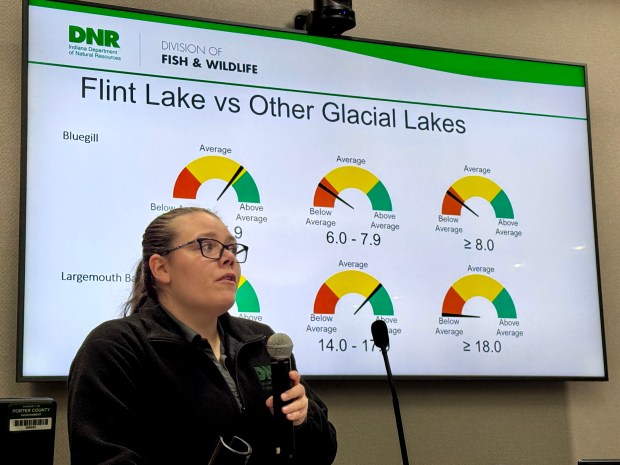Invasive weeds are so bad at Flint Lake on Valparaiso’s north side that during last year’s Department of Natural Resources fish management survey, the DNR had to stop two or three times to clean off its boat’s propellers, biologist Courtney Weldon said.
Fragmentation, chopping it up, is what spreads the problematic plant.
“If you’ve ever boated through them, you understand how a bass feels,” she said.
Weldon, the DNR’s fisheries biologist for 14 northwestern Indiana counties, said Eurasian watermilfoil, the only nonnative aquatic vegetation in Flint Lake, was one of the two most abundant species.
She explained the results of last year’s survey of Flint Lake at a Valparaiso Chain of Lakes Watershed Group program on Monday.
“Doing a treatment for Eurasian milfoil could be beneficial,” Weldon said. By removing the invasive plant, water quality would improve and fish could survive more easily. Allowing sunlight to penetrate deeper into the lake is beneficial for photosynthesis, which releases oxygen into the water.
Flint Lake’s habitable zones for fish – water with sufficient oxygen – don’t go as deep as they should for a glacial lake, she said.
Also contributing to the spread of aquatic vegetation in Flint Lake is fertilizer runoff by lawns adjacent to the lake, Chain of Lakes Watershed Group President Walt Breitinger said.
“All of the glacial lakes were phosphorous-limited, and a little of it goes a long way,” Weldon said.
Sediment also runs into the lake, making it more shallow and reducing the clarity of the water.
Referring to northern pike in the lake, “I’m expecting that most of your large individuals aren’t making it through the summer,” Weldon said.
Bluegill in the lake aren’t growing as fast as might be expected, either.
“What’s coming in from your watershed plays a big role in how your lake is doing,” Weldon said.
“Doing a treatment for Eurasian milfoil could be beneficial,” she said.
That’s a tricky issue, too. The milfoil is becoming more resistant to the chemical most commonly used to treat it. And the herbicide used should be specific to milfoil so it doesn’t endanger the native plants.
“Anytime you damage these plants, you’re killing hundreds of thousands of babies,” Weldon said. Smaller fish often feed among the plants and hide from predators there.
Gizzard shad, the second most abundant fish species, is a less desirable type. “There’s no good solution to get rid of shad. They’re contributing to your water quality” problems by stirring up sediment from the bottom of the lake, she said.
“I think walleye would enhance your fishing” and provide a predator in open water. The fish survey listed walleye as the second least abundant species, with only one caught.
The DNR doesn’t currently have plans for stocking Flint Lake, though. “In a glacial lake, a lot of times stocking a lake is throwing more fish into a system that is already maxed out,” she said.
Also, the state can’t produce enough walleye in its fisheries to meet that kind of demand throughout the state.
The Friends of Fishing group has stocked walleye at Loomis Lake, at a cost of about $1,600 for 500 fish, one of the group’s members said.
Doug Ross is a freelance reporter for the Post-Tribune.



